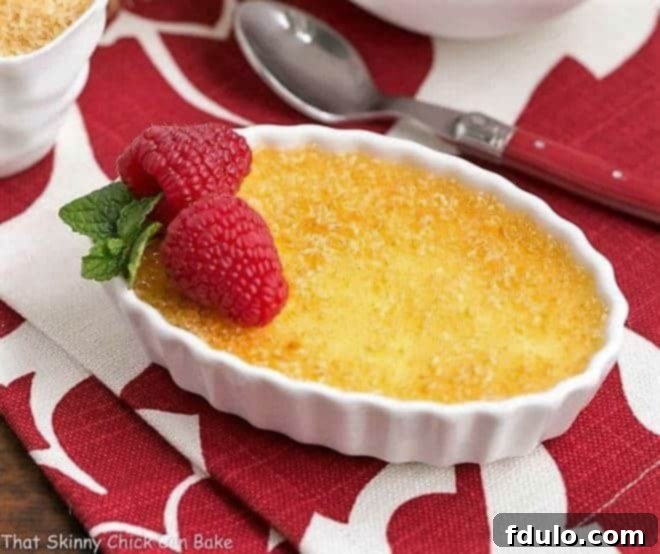Welcome to the definitive guide for creating the most exquisite Classic Crème Brûlée, a timeless dessert that promises to captivate your senses. This particular Crème Brûlée recipe holds a special place, as it was the very first I attempted, nearly two decades ago, inspired by a feature on Martha Stewart’s show. Since then, no other version has quite measured up to its unparalleled richness and perfect caramelization, solidifying its status as a cherished family tradition.
The magic begins with a velvety vanilla custard, transformed into an extraordinary after-dinner indulgence by a crisp, caramelized sugar topping. The satisfying crack of a spoon breaking through the hardened sugar crust, revealing the silken smooth custard beneath, is the quintessential moment that makes this Easy Creme Brulee Recipe so famously irresistible. It’s a symphony of textures and flavors that embodies simple elegance and gourmet delight.

Why This Crème Brûlée Recipe Is a Must-Make
Crème brûlée, often referred to as “Burnt Cream” or “Trinity Cream,” is a French dessert renowned for its luxurious, creamy custard base and its distinctive, brittle layer of caramelized sugar. What makes this specific rendition truly outstanding and a non-negotiable addition to your dessert repertoire?
- Unrivaled Taste: Once you experience the depth of flavor and perfect consistency of this Classic Crème Brûlée at home, you might find, like my husband Bill, that restaurant versions simply fall short. It sets a new standard for what this dessert should be.
- A Culinary Legend: This isn’t just any recipe; it hails from Le Cirque, New York City’s legendary restaurant. Le Cirque was celebrated for its innovative take on classic French cuisine, and their crème brûlée was a standout. Bringing this iconic dessert into your kitchen allows you to recreate a piece of culinary history.
- The Quintessential Experience: This recipe delivers precisely what crème brûlée should be: a rich, tender custard that melts in your mouth, perfectly contrasted by a crackable, slightly bitter caramelized sugar topping. It’s the ideal balance of creamy and crunchy, sweet and subtly burnt, making it the quintessential crème brûlée experience.
Whether you’re a seasoned baker or a curious novice, mastering this dessert is immensely rewarding. It’s elegant enough for a special occasion yet surprisingly straightforward to prepare, promising to impress anyone lucky enough to taste it.

Essential Ingredient Notes for Perfect Crème Brûlée
The magic of crème brûlée lies in the quality and proper handling of its few, but crucial, ingredients. Let’s delve into each one to ensure your dessert is nothing short of perfection.
- Granulated Sugar (Kitchen Staples): Standard white granulated sugar is essential for both the custard base and, optionally, for the caramelized topping. Its fine crystals dissolve easily into the cream, ensuring a smooth custard.
- Heavy Cream (36% Butterfat): Do not substitute! The high butterfat content of heavy cream (often labeled as “heavy whipping cream”) is what gives crème brûlée its signature richness and luxurious, silky texture. Lower-fat creams will result in a less decadent and potentially thinner custard.
- Vanilla Bean: The heart of this classic dessert’s flavor. Using a whole vanilla bean, split lengthwise with seeds scraped out, imparts an unparalleled aromatic depth. Both the fragrant seeds and the pod are simmered in the cream to infuse maximum vanilla essence. While vanilla extract can be used in a pinch, it won’t yield the same complex flavor profile.
- Egg Yolks: These are the primary thickeners and enrichers for the custard. Using only yolks provides an incredibly smooth, custardy texture without the rubberiness that egg whites can sometimes contribute. For best separation, ensure your eggs are cold. Save those leftover egg whites for other delightful recipes!
- Salt: A small pinch of salt is a non-negotiable flavor enhancer. Just as it elevates savory dishes, salt balances the sweetness and deepens the overall flavor of desserts, preventing them from tasting bland or one-dimensional. Opt for fine table salt as it dissolves more readily than coarse kosher salt.
- Turbinado Sugar (Sugar in the Raw): This coarse, blonde-colored sugar, with its delicate molasses notes, is ideal for the signature brittle crust. Its larger crystals caramelize beautifully under high heat, creating a robust, crackable layer. To achieve the perfect brulee, you’ll use either a handheld kitchen torch or your oven’s broiler. If using the broiler, keep the oven door slightly ajar and watch vigilantly; the goal is a golden-brown, melted sugar crust, not a burnt one.
Mastering the Art of Crème Brûlée: A Step-by-Step Guide
Creating this gourmet dessert at home might seem intimidating, but with these detailed steps, you’ll achieve perfection every time. The process involves careful heating, tempering, and a gentle bake to ensure a consistently creamy custard.

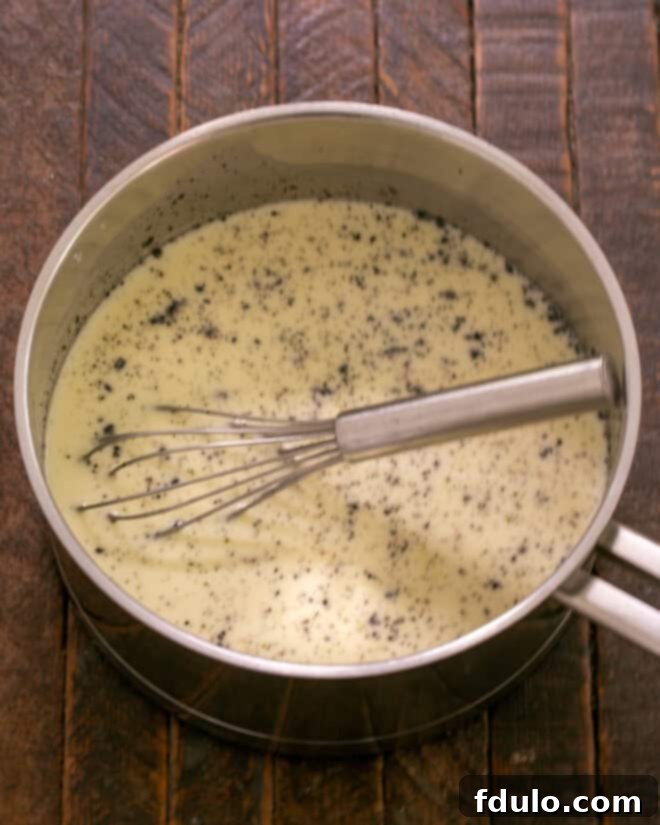
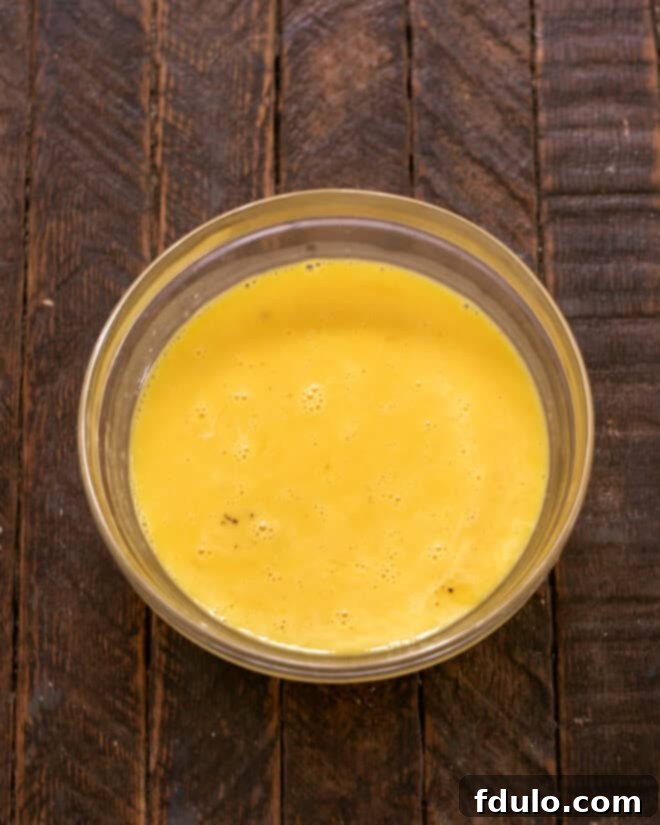

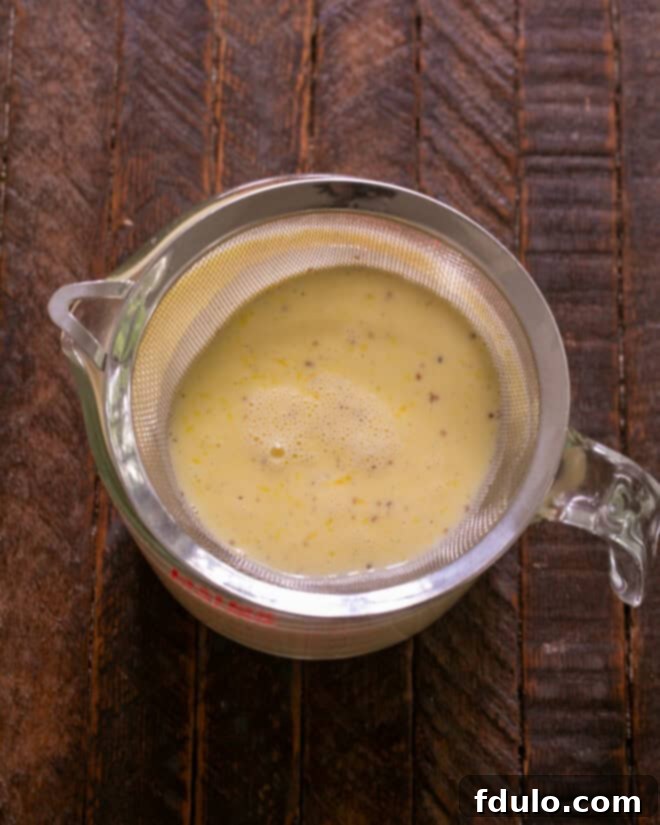
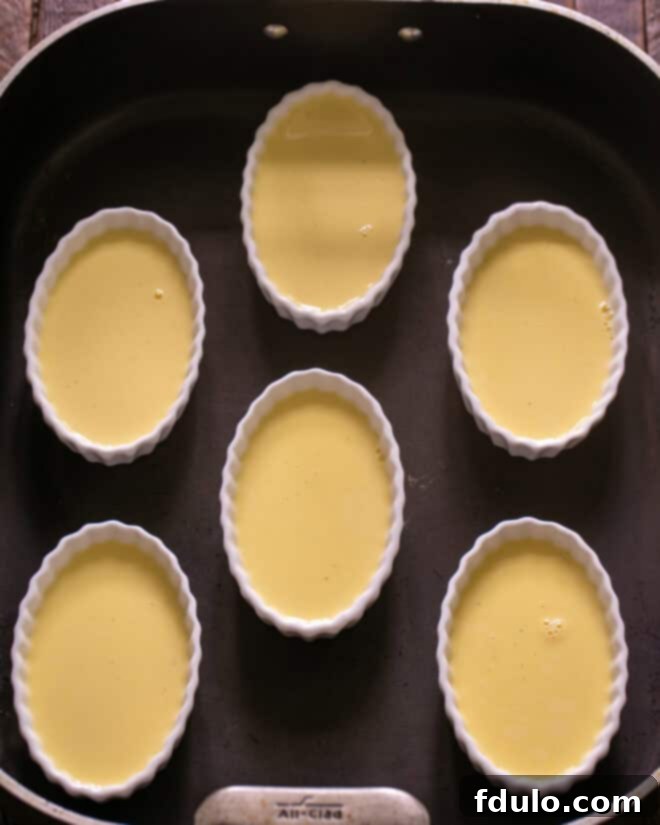

Expert Tips for Crème Brûlée Perfection
Once you master the fundamentals of making crème brûlée, it will quickly become a go-to dessert for any occasion – from intimate family dinners to festive holiday gatherings. Here are invaluable tips to ensure your crème brûlée is consistently flawless:
- PRO-Tip: The Art of Tempering: When incorporating the whisked egg yolks into the hot cream mixture, absolute patience is key. Pour the hot cream into the yolks very slowly, in a thin stream, while whisking the yolks constantly and vigorously. This gradual introduction of heat prevents the egg yolks from scrambling and ensures a perfectly smooth, lump-free custard base. Rushing this step is the most common cause of textural issues.
- PRO-Tip: Sieve for Silkiness: For the ultimate smooth and creamy results, always pass your custard mixture through a fine-mesh sieve just before pouring it into the ramekins. Even with careful tempering, tiny bits of egg can sometimes coagulate. Straining eliminates these imperfections, guaranteeing a luxurious, velvety texture that is the hallmark of a truly great crème brûlée.
- Addressing Coagulated Eggs: If, despite your best efforts, you find a significant amount of cooked egg bits after mixing, it typically means the hot cream was added too quickly or whisking wasn’t constant enough. This is more than just a textural issue; it indicates that there isn’t enough emulsified egg in your custard to set properly. In such cases, it’s often best to start over to avoid a runny or unset dessert. Don’t be discouraged; practice makes perfect!
- Chilling is Crucial: Allow your baked custards to cool completely at room temperature, then chill them in the refrigerator for at least 2 hours, and preferably 4 hours or more, before serving. This chilling time allows the custard to fully set and firm up, ensuring the ideal contrast with the warm, freshly caramelized sugar topping.
- Choosing the Right Sugar Topping: While granulated sugar can work, Turbinado sugar (also known as sugar in the raw) is highly recommended for the topping. Its coarser crystals and slight molasses flavor create a superior, more robust caramelized crust that cracks beautifully.
- Mastering the Brulee: You have two primary methods for caramelizing the sugar: a kitchen torch or your oven’s broiler. A small culinary torch offers the most control, allowing you to melt and brown the sugar evenly. If using the broiler, place the ramekins directly under the heating element, about 4-6 inches away, and watch them with extreme vigilance. The sugar can go from perfectly golden to burnt in a matter of seconds. Keep the oven door slightly ajar so you can monitor the process without interruption.
- PRO-Tip: The Power of Salt: Don’t skip the pinch of salt in the custard mixture. It might seem counterintuitive for a dessert, but salt is a powerful flavor enhancer. It brightens and accentuates the sweet vanilla notes, preventing the dessert from tasting flat and creating a more complex, well-rounded flavor profile.
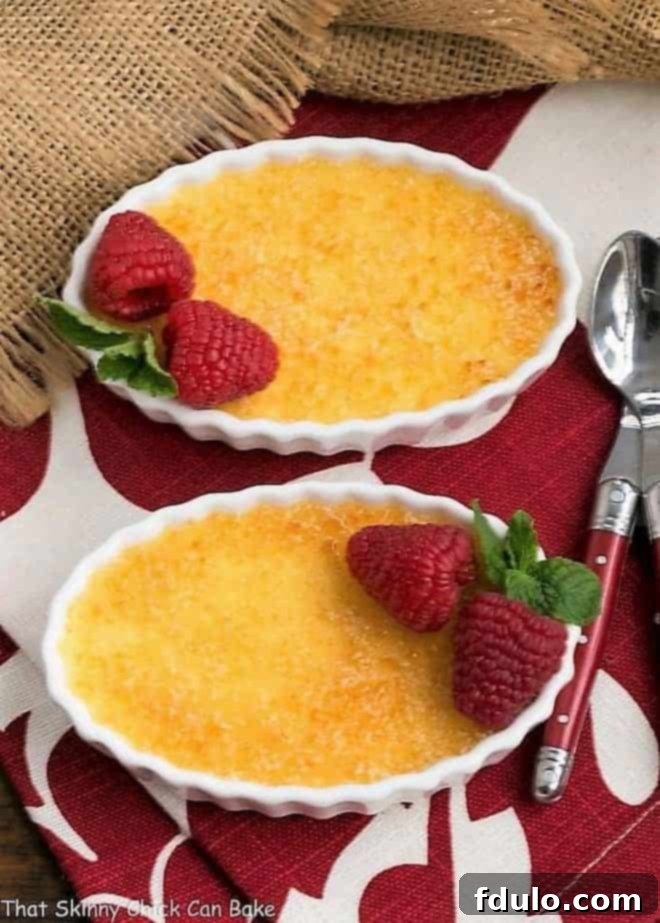
Essential Crème Brûlée Equipment
Having the right tools can make all the difference in achieving perfect crème brûlée. While many items are common kitchen staples, a few specialized pieces will elevate your experience and results.
- Ramekins: These small, individual oven-safe dishes are crucial. While round, deeper ramekins work, I highly recommend investing in flat oval ramekins. Their shallower depth allows for a quicker, more even bake and provides a larger surface area for the caramelized sugar crust, which is arguably the best part! If using deeper ramekins, be prepared to extend your baking time slightly to ensure the custard is fully set. A slight jiggle in the center is desirable, indicating a creamy texture, but the perimeter should be firm.
View shallow ramekins on Amazon. - Bain-Marie (Water Bath): Crème brûlée is traditionally baked in a bain-marie, the French term for a water bath. This method involves placing your ramekins into a larger baking dish or roasting pan and filling the larger pan with hot water, typically halfway up the sides of the ramekins. The water bath provides a gentle, consistent heat, preventing the custards from curdling or overcooking, resulting in an incredibly smooth and creamy texture. Ensure no water splashes into the ramekins. My roasting pan works perfectly for this.
View roasting pans on Amazon. - Culinary Torch or Broiler: For achieving that iconic crackable sugar topping, you’ll need a heat source capable of caramelizing sugar quickly. A culinary torch is the preferred method as it offers precision and control. Alternatively, your oven’s broiler can be used, but requires careful monitoring to prevent burning.
The Importance of Straining the Custard
Achieving that perfectly silky, uniform custard texture is paramount for an authentic crème brûlée, and straining is a non-negotiable step to guarantee it.
- The custard mixture needs to be strained through a fine-mesh sieve before it’s poured into the ramekins. Even if you meticulously follow the tempering process by slowly adding hot cream to the eggs while continuously whisking, tiny bits of egg can sometimes cook or coagulate. These small imperfections, if left unstrained, will compromise the luxurious smoothness of your final custard.
- A Word of Caution: If, after mixing, you find a significant amount of cooked egg bits rather than just a few tiny specks, it’s a strong indicator that the hot cream was added too rapidly and/or you didn’t whisk consistently enough. When this happens, a substantial portion of the egg protein might have coagulated prematurely, meaning there won’t be enough functional egg in your custard to allow it to set properly during baking. Unfortunately, this often necessitates starting over to ensure the custards solidify correctly. Trust me, I speak from experience!
- PRO-Tip for Easy Pouring: To make pouring the strained custard into the ramekins a breeze, I highly recommend straining the mixture directly into a 4-cup Pyrex measuring cup. Its built-in spout provides excellent control, allowing you to neatly fill each ramekin without spills or mess.
Perfecting the Caramelized Sugar Topping
The iconic crackable sugar crust is what elevates crème brûlée from a simple custard to a masterpiece. Mastering this final step is key to the authentic experience.
- When it comes to the sugar for your topping, you have a few options, though Turbinado sugar (also known as sugar in the raw) is my top recommendation. Its larger crystals and subtle molasses notes provide a beautiful, brittle, and flavorful crust. You can also use brown sugar for a softer caramel flavor or even fine granulated sugar, though the results might be slightly less robust. Some pastry chefs advocate for applying a thin layer of sugar, torching it, and then repeating the process for a multi-layered crunch. Personally, I find a single, even layer is usually sufficient and delivers excellent results.
- For caramelizing the sugar, you have a choice between a culinary torch and your oven’s broiler. While I used to favor the broiler, a handheld culinary mini-torch is now my preferred method. It offers superior control, allowing you to melt and brown the sugar precisely without heating the custard excessively. If you opt for the broiler, place the ramekins directly under the heating element and watch them meticulously. The sugar can go from perfectly caramelized to burnt charcoal in mere seconds. Remove them as soon as the sugar starts bubbling and turns a rich, golden brown. If you’re comfortable and safety-conscious, some even use a larger welding torch for faster, more intense caramelization, but a kitchen-specific torch is safer and more appropriate for most home cooks.
Serving Your Exquisite Crème Brûlée
The presentation and timing of serving crème brûlée are almost as important as its preparation, ensuring the perfect temperature and textural contrast.
- Chill Before Torch: It is imperative to chill your crème brûlée thoroughly for at least two hours (or up to three days) before attempting to caramelize the sugar. This ensures the custard remains cold and firm when exposed to the intense heat of the torch or broiler. If the custard is warm, the heat from caramelizing the sugar can cause it to liquefy around the edges, compromising the perfect creamy texture. (Though, let’s be honest, a slightly melty crème brûlée is rarely turned down!)
- Garnishing for Elegance: While this classic crème brûlée is utterly delightful served unadorned, a thoughtful garnish can elevate its presentation, especially when entertaining. For a touch of color and freshness, consider adding a few fresh raspberries or elegantly sliced strawberries. A small sprig of fresh mint or a dusting of confectioners’ sugar can also add visual appeal.
- The Unsung Hero: Salt: As Jenni Field, an accomplished pastry chef, wisely points out, a small pinch of salt in desserts makes a world of difference. It’s not about making the dessert salty, but rather enhancing and balancing the sweetness and rich vanilla notes, preventing the overall flavor from falling flat. This subtle addition truly rounds out the taste profile of this vanilla bean custard.
- Make Ahead Convenience: One of the best features of crème brûlée is that the custards can be prepared and baked well in advance, stored covered in the refrigerator for up to three days. This makes it an ideal dessert for entertaining, as you only need to perform the final caramelization step right before serving. The “brulee” effect is always best when freshly torched, offering that irresistible crack.
- For a truly memorable treat, especially for a romantic occasion like Valentine’s Day, consider making this easy crème brûlée recipe for your loved ones. Its elegance and decadent flavor are sure to impress.

Creative Recipes to Utilize Extra Egg Whites
After preparing this crème brûlée recipe, you’ll find yourself with seven large egg whites. Rather than discarding them, embrace the opportunity to create other delicious treats! Egg whites are versatile and can be transformed into light, airy, and delightful desserts. Here are some fantastic recipes that put those leftover egg whites to good use:
- For 2 egg whites: Simple Meringue Cookies – Light, crisp, and delicate cookies perfect for a sweet bite.
- For 3 egg whites: Chocolate Velvet Pie – A rich, smooth chocolate pie often crowned with a fluffy meringue.
- For 4 egg whites: Fresh Strawberry Souffles – Elegant, airy, and bursting with fresh fruit flavor.
- For 6 egg whites: Chocolate Raspberry Pavlova – A stunning dessert with a crisp meringue shell, soft interior, and fresh berries.
- For 7 egg whites: Fresh Strawberry Meringue Cake – A show-stopping cake featuring layers of sweet meringue and fresh strawberries.
Frequently Asked Questions About Crème Brûlée
Crème Brûlée is a French phrase that literally translates to “Burnt Cream.” While the accent marks might seem daunting, its pronunciation is quite straightforward: it’s pronounced krehm-broo-LAY. Mastering the pronunciation adds to the authentic experience of this classic dessert.
Absolutely, making crème brûlée ahead of time is one of its greatest advantages, especially when entertaining. PRO-Tip: The baked custards can be stored in the refrigerator for up to 3 days. Simply cover them tightly with plastic wrap to prevent a skin from forming or absorbing refrigerator odors. The sugar topping, however, should always be sprinkled and torched just before serving to ensure the crispest crust.
While a Creme Brulee Torch or culinary torch is the preferred method for melting the sugar topping due to its precision and control, your oven’s broiler can certainly work in a pinch. PRO-Tip: To use the broiler, place the dishes of crème brûlée on a sheet pan about 4 inches from the heating element. You must watch them continuously and very carefully, as the sugar can burn extremely quickly. Line up your ramekins directly beneath the heat source for even caramelization. Remove them as soon as the sugar melts and turns golden brown.
No, New York City’s Le Cirque restaurant did not invent crème brûlée, but they were instrumental in its resurgence and popularization in the United States. Versions of crème brûlée, or “burnt cream” desserts, can be traced back as far as 15th-century England, and a similar Spanish dessert dates back to Medieval times. Le Cirque famously featured it on their menu in the 1980s, introducing it to a wider American audience and sparking a nationwide craze for the elegant dessert.
Crème brûlée offers a delightful and unforgettable sensory experience. The base is a smooth, incredibly silky, and rich vanilla custard that melts in your mouth, infused with the aromatic warmth of real vanilla bean. This tender custard is perfectly contrasted by a thin, brittle layer of caramelized sugar on top. The moment you crack through this slightly bitter, smoky crust to reach the sweet, cool custard beneath is pure dessert bliss, making it a truly memorable and exquisite treat.
Explore More Decadent Dessert Recipes
If you’ve fallen in love with the rich flavors and delightful textures of crème brûlée, you’re in for a treat! The versatility of this classic dessert has inspired countless variations and related recipes that capture its essence in new and exciting ways. Dive into these other fabulous dessert ideas:
- Creme Brulee Cookie Bars from Crazy for Crust – All the flavors of crème brûlée in a convenient, shareable bar format.
- No-churn Creme Brulee Ice Cream from Big Bear’s Wife – Enjoy the iconic flavor profile in a cool, creamy scoop.
- Creme Brulee French Toast – A luxurious breakfast or brunch dish, perfect for special mornings.
- Creme Brulee Cheesecake – A decadent fusion of two classic desserts, offering rich creaminess with a burnt sugar topping.
- White Chocolate Creme Brulee – A delightful twist on the classic, with the added sweetness and richness of white chocolate.
- Creme Brulee with Raspberries – Fresh raspberries add a bright, tart counterpoint to the rich custard.
- More of the Best Dessert Recipes – A curated collection of irresistible sweets for every craving.
Stay connected and share your culinary creations with me through social media! You can find me on Instagram, Facebook, and Pinterest. Don’t forget to tag me @thatskinnychickcanbake when you try one of my recipes! If you adore the results, please consider leaving a 5-star rating in the recipe card below to help other home bakers discover these delicious treats.
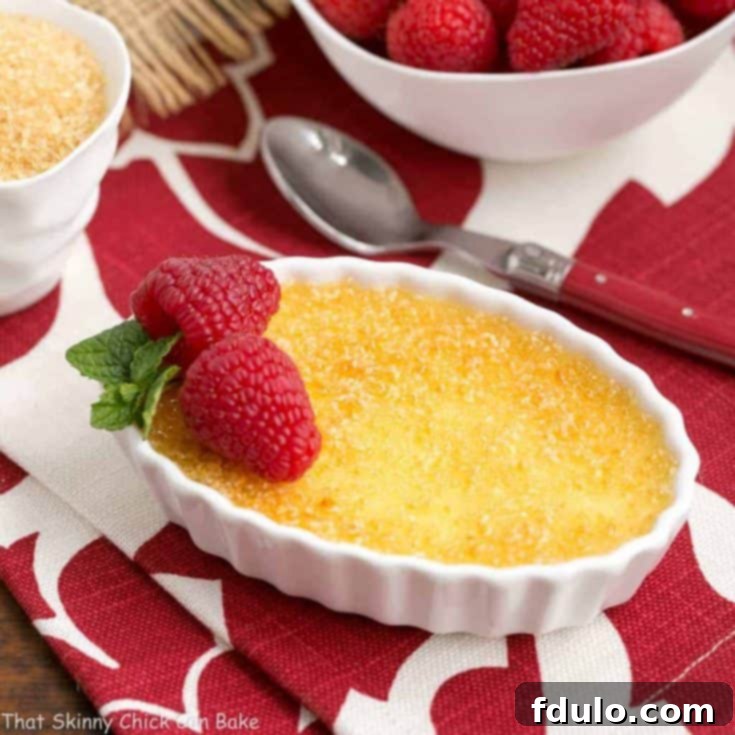
Classic Crème Brûlée Recipe
15 minutes
50 minutes
1 hour 5 minutes
9 servings
A creamy vanilla custard topped with a crisp “burnt” sugar topping, this Classic Crème Brûlée recipe from Le Cirque is a timeless dessert that will impress everyone.
Ingredients
- 4 cups heavy cream (36% butterfat)
- 1 vanilla bean, slit in half lengthwise and seeds scraped
- ¾ cup granulated sugar
- Pinch of salt (fine table salt recommended)
- 7 large egg yolks
- Turbinado sugar (sugar in the raw) for topping
Instructions
- Preheat your oven to 300ºF (150ºC). Prepare a large roasting pan to act as a water bath (bain-marie).
- In a heavy-bottomed saucepan, combine the heavy cream, vanilla pod, scraped vanilla seeds, granulated sugar, and salt. Heat over medium heat, stirring occasionally, until small bubbles just begin to form around the perimeter of the pan. It’s crucial not to let the mixture come to a full boil. Remove the saucepan from the heat immediately.
- While the cream mixture is heating, whisk the 7 large egg yolks in a large glass measuring cup or a mixing bowl until they are light yellow and smooth. To temper the yolks, slowly drizzle a small amount (about ¼ cup at a time) of the hot cream mixture into the whisked yolks, whisking constantly and vigorously. Repeat this process a few more times, gradually increasing the temperature of the yolks without cooking them. This prevents the eggs from scrambling when combined with the hot cream.
- Once tempered, slowly pour the yolk mixture back into the saucepan with the remaining hot cream, whisking continuously until the mixture is smooth and fully combined. For an impeccably silky custard, strain the entire mixture through a fine-mesh sieve into a clean bowl or back into the large measuring cup (if it has a spout) to remove any vanilla bean remnants or small cooked egg bits.
- Arrange nine 8-ounce ramekins in your prepared roasting pan. Evenly fill the ramekins to the top with the strained custard mixture. Carefully place the roasting pan into the preheated oven. Then, pour enough hot water into the roasting pan to come halfway up the sides of the ramekins, creating a water bath. Bake for approximately 50 minutes, or until the custard is set around the perimeter but still has a slight, gentle jiggle in the center when shaken.
- Carefully remove the ramekins from the water bath and let them cool completely at room temperature for about 30 minutes. Once cool, transfer them to the refrigerator and chill for at least 2 hours, or ideally up to 3 days, covered with plastic wrap. Before serving, sprinkle an even, thin layer of turbinado sugar over the top of each chilled custard. Use a kitchen torch to caramelize the sugar until it melts, bubbles, and turns a rich, golden brown, forming a crisp crust. As an alternative, you can place them under a preheated broiler (about 4 inches from the element), but watch VERY carefully as the sugar can burn quickly.
- Place each perfectly torched crème brûlée on a small plate to serve immediately, allowing guests to enjoy the delightful contrast of textures and temperatures.
- Note: If you use shallow ramekins, they may bake slightly faster, often in about 40 minutes, so adjust baking time accordingly and watch for the gentle jiggle.
Notes
For easier separation of egg whites and yolks, it’s best to separate your eggs when they are cold, as the yolk is less likely to break. Store the leftover egg whites in an airtight container in the refrigerator for up to 3-4 days or freeze them for longer storage.
Recommended Products
As an Amazon Associate and member of other affiliate programs, I earn from qualifying purchases.
- Turbinado Sugar
- Roasting Pan
- Shallow Ramekins
- Culinary Torch
Nutrition Information:
Yield:
9
Serving Size:
1 creme brulee
Amount Per Serving:
Calories: 488Total Fat: 42gSaturated Fat: 26gTrans Fat: 1gUnsaturated Fat: 14gCholesterol: 285mgSodium: 100mgCarbohydrates: 20gFiber: 0gSugar: 20gProtein: 8g
HOW MUCH DID YOU LOVE THIS RECIPE?
Please leave a comment on the blog or share a photo on Pinterest
